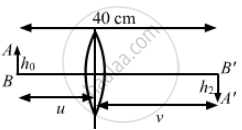Advertisements
Advertisements
Question
A pin of length 2.00 cm is placed perpendicular to the principal axis of a converging lens. An inverted image of size 1.00 cm is formed at a distance of 40.0 cm from the pin. Find the focal length of the lens and its distance from the pin.
Solution
Given,
Height of the object, (h0) = 2 cm,
Height of the image, (h1) = 1 cm
distance between image and object, ( \[-\] u + v) = 40 cm 
We know that,
Magnification is given by:
\[m = \frac{h_i}{h_0} = \frac{v}{u}, \frac{1}{2} = \frac{v}{- u}\]
u = −2v
Using lens formula,
\[\frac{1}{v} - \frac{1}{u} = \frac{1}{f}\]
\[ \Rightarrow \frac{1}{v} - \frac{1}{- 2v} = \frac{1}{f}\]
\[ \Rightarrow \frac{1}{v} + \frac{1}{2v} = \frac{1}{f}\]
\[ \Rightarrow f = \frac{2v}{3}\]
As per the question,
= −u + v = 40 cm,
= −(−2v) + v = 40 cm,
= 3v = 40 cm
\[v = 13 . 3 = \frac{40}{3} cm, u = \frac{80}{3}\]
∴ f = 8.9 cm
Hence, the required focal length is 8.9 cm and object distance is 26.66 cm.
APPEARS IN
RELATED QUESTIONS
Calculate the focal length of a corrective lens having power +2.5 D.
What can you see in a completely dark room? If you switch on an electric bulb in this dark room as a light source, explain how you could now see:
(a) the electric bulb
(b) a piece of white paper
Consider two statements A and B given below:
A: real image is always inverted
B: virtual image is always erect
Out of these two statements:
Which one of the following materials cannot be used to make a lens?
Which type of lens has (a) a positive power, and (b) a negative power?
Which of the two has a greater power: a lens of short focal length or a lens of large focal length?
What is the power of a convex lens of focal length 0.5 m?
The power of a combination of two lenses X and Y is 5 D. If the focal length of lens X be 15 cm :
(a) calculate the focal length of lens Y.
(b) state the nature of lens Y.
Two lenses A and B have focal lengths of +20 cm and, −10 cm, respectively.
(a) What is the nature of lens A and lens B?
(b) What is the power of lens A and lens B?
(c) What is the power of combination if lenses A and B are held close together?
State the condition for the following a ray passes undeviated through the lens .
A double convex lens has two surfaces of equal radii R and refractive index \[m = 1 \cdot 5\]
A screen is placed a distance 40 cm away from an illuminated object. A converging lens is placed between the source and the screen and its is attempted to form the image of the source on the screen. If no position could be found, the focal length of the lens
Consider the situation described in the previous problem. Where should a point source be placed on the principal axis so that the two images form at the same place?
Surabhi from std. X uses spectacle. The power of the lenses in her spectacle is 0.5 D.
Answer the following questions from the given information:
- Identify the type of lenses used in her spectacle.
- Identify the defect of vision Surabhi is suffering from.
- Find the focal length of the lenses used in her spectacle.
What is meant by the power of accommodation produced?
A convex lens is of focal length 20 cm. Find its power.
Focal length : metre : : power of lens : _______
Assertion and reasoning type
- Assertion: Myopia is due to the increase in the converging power of eye lens.
- Reason: Myopia can be corrected with the help of concave lens.
The focal length of a double convex lens is equal to the radius of curvature of either surface. What is the refractive index of its material?
